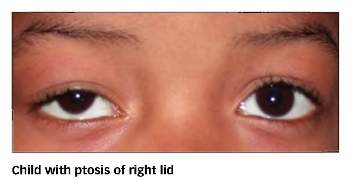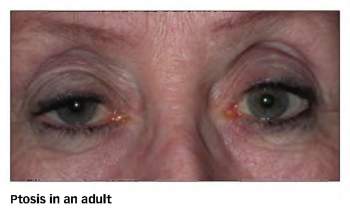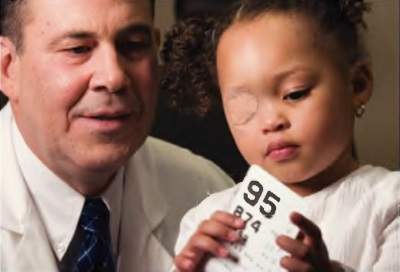Ptosis in Children and Adults
A Closer Look
What is Ptosis?

Ptosis (pronounced TOH-sis) is a drooping of the upper eyelid. The lid may droop only slightly, or it may cover the pupil entirely, in some cases, ptosis can restrict and even block normal vision. It can be present in children as well as adults and may be treated with surgery.
Ptosis can:
- Affect one or both eyelids
- Be inherited
- Be present at birth
- Occur later in life

Ptosis that is present at birth is called congenital ptosis. If a child is born with moderate to severe ptosis, treatment may be necessary to allow for normal visual development.
Ptosis in Children
Congenital ptosis is often caused by poor development of the muscle that lifts the eyelid, called the levator muscle. Although it is usually an isolated problem, a child born with ptosis may also have:
- Eye movement abnormalities
- Muscular diseases
- Lid tumors or other tumors
- Neurological disorders
- Refractive errors
Congenital ptosis usually does not improve with time.
What Are the Signs and Symptoms of Ptosis?
The most obvious sign of ptosis in children is the drooping lid itself, in congenital ptosis, there is often asymmetry of the upper eyelid creases. Children with ptosis may also often tip their heads back into a chinup position to see underneath the drooping eyelid, or they may raise their eyebrows in an attempt to lift up the lids. These head and facial maneuvers are signs that the child is trying to use both eyes to see. Over many years, abnormal head positions may cause deformities in the head and neck.
What Problems Can Result From Ptosis in Children?
The most serious problem associated with childhood ptosis is amblyopia ("lazy eye"). Amblyopia is poor vision in an eye that did not develop normal sight during early childhood. This can occur if the lid is drooping severely enough to block the child's vision. More frequently, it can occur because ptosis tends to change the optics of the eye, causing astigmatism, with constant blurring of the visual image. Finally, ptosis can hide misaligned or crossed eyes, which can also cause amblyopia.
If amblyopia is not treated early in childhood, it persists throughout life and may lead to permanent vision loss.
How is Congenital Ptosis Treated?

In most cases, the treatment for childhood ptosis is surgery. If amblyopia is present, treatment with patching, eyeglasses or eyedrops may also be necessary, in determining whether or not surgery is necessary and which procedure is the most appropriate, an ophthalmologist (Eye M.D.) must consider a few important factors:
- The child's age
- Whether one or both eyelids are involved
- The eyelid height
- The eyelid's lifting and closing muscle strength
- The eye's movements
During surgery the levator, or eyelid-lifting muscle, is tightened, in severe ptosis, when the levator muscle is extremely weak, the lid can be attached or suspended from under the eyebrow so that the forehead muscles can do the lifting.
Mild or moderate ptosis usually does not require surgery early in life. Children with ptosis, whether they have had surgery or not, should be examined regularly by an ophthalmologist for amblyopia, refractive disorders and associated conditions. Even after surgery, focusing problems can develop as the eyes grow and change shape.
What Causes Adult Ptosis?
The most common cause of ptosis in adults is the separation or stretching of the levator muscle tendon from the eyelid. This process may occur:
- As a result of aging
- After cataract or other eye surgery
- As a result of an injury
Adult ptosis may also occur as a complication of other diseases involving the levator muscle or its nerve supply, such as neurologic and muscular diseases and, in rare cases, orbital tumors.
How is Adult Ptosis Treated?
Your ophthalmologist can provide:
- A comprehensive assessment of your ptosis
- A discussion of the available treatment methods
- Information about possible risks and complications
Your ophthalmologist may use blood tests, X-rays or other tests to determine the cause of the ptosis and plan the best treatment. If treatment is necessary, it is usually surgical. Sometimes a small tuck in the lifting muscle and removal of excess eyelid skin can raise the lid sufficiently. More severe ptosis requires reattachment and strengthening of the levator muscle.
What Are the Risks of Ptosis Surgery?
The risks of ptosis surgery include infection, bleeding and reduced vision, but these complications occur very infrequently, immediately after surgery, you may find it difficult to completely close your eye, but this is only temporary. Lubricant eyedrops and ointment can be helpful during this period.
Although improvement of the lid height is usually achieved, the eyelids may not appear perfectly symmetrical, in rare cases, full eyelid movement does not return, in some cases, more than one operation may be required.
Summary
Ptosis in both children and adults can be treated with surgery to improve vision as well as cosmetic appearance. It is very important that children with ptosis have regular ophthalmic examinations early in life to protect them from the serious consequences of untreated amblyopia.




